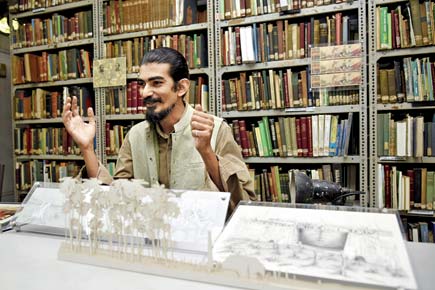An exhibit discusses the price of reclamation, just the subject Mumbai must ponder over, given the Coastal Road debate

If you spot Flash Gordon comics panels in the library premises of Bombay Natural History Society (BNHS) at Lion’s Gate, pay attention to the text. They talk of olive ridley turtles on Old Woman’s Island and mangroves that were lost during the reclamation of colonial Bombay.

Ranjit Khandalgaonkar at BNHS. Pic/Shadab Khan
ADVERTISEMENT
“There used to be a pond where Rampart Row (Kala Ghoda) is now, and documents indicate that a submerged forest was revealed during the reclamation of Princess Harbour,” says visual artist and researcher Ranjit Kandalgaonkar.
His exhibit, Isles Amidst Reclamation, is presented by Mohile Parikh Centre and will be on display for the public at the BNHS library and the researchers’ room at the Maharashtra State Archives housed inside Elphinstone College, until December 19.
With the use of sepia-tinted faux manuscripts, digitally manipulated Flash comics, sketches and laser-cut panels, Kandalgaonkar’s exhibit is an ecological timeline of the various flora and fauna that were lost between the seven Bombay islands from the 18th century onwards.
Mudflats gave way to causeways. The creation of today’s shopping and art district of Colaba Causeway in 1838 is one such development. Twenty-two hilltops across the city were destroyed and the resultant debris used to bridge gaps between the islands.
Going through records, mainly belonging to taxonomists and the British East India Company at the KR Cama Oriental Institute, Asiatic Library, the Maharashtra State Archives, the natural history section at the Chhatrapati Shivaji Maharaj Vastu Sanghralaya (CSMVS), and of course the BNHS, Kandalgaonkar stumbled on some surprises.
The British had recorded leopard sightings at Kalbadevi, civets, tigers in Malabar Hill and Pydhonie, and hammerhead sharks off the coast. Kandalgaonkar’s 3D tableau of a Worli saw mill, on display at the State Archives is a take on the rampant destruction of coconut forests that once flourished in the area.
“Bombay used to be wild,” says the artist. “A national park is about conservation within boundaries. Two hundred years ago, such a boundary didn’t exist and we were entering the habitat of local flora and fauna,” he continues. The references to Flash are pertinent, then, since the comics mash-up sci-fi advancements (such as lasers guns) with an irrepressible nature (poisonous mushrooms, for example).
The project is part of Mohile Parikh Centre’s public art and intervention programme, called the Geographies of Consumption. The Mumbai-based arts and cultural centre has been conducting a series such exhibitions and performances to comment on questions of environment and ecology.
“We are working with artists who have been responding to urbanism and consumption through their art,” says art historian Amrita Gupta Singh, programme director at Mohile. Previously, a public performance by Sahaj Rahal at the Vasai Fort had commented on nomadism, and an upcoming installation by Anupam Singh will focus on the saltpans of Vasai.
Kandalgaonkar, who has been researching the formation of urban Mumbai even in previous projects, says, “From 1760-1790, the British East India Co and the Bombay Council were debating the pros and cons of reclamation of the islands that comprised Bombay. Reclamation was a ‘solution’ to deal with issues of hygiene and low lying mud flats that caused flooding due to high tide.
This subsequent reclamation, although conceived and executed to solve a localised problem, in fact, triggered a 300 year reclamation of the city connecting it to issues of land, revenue, politics etc.” And, in case we are wondering if Old Woman’s Island is a fictional place from a Flash comic, it wasn’t. That was the name for a part of modern day Colaba.
 Subscribe today by clicking the link and stay updated with the latest news!" Click here!
Subscribe today by clicking the link and stay updated with the latest news!" Click here!







